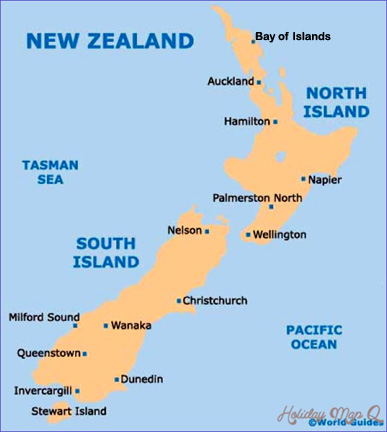
| New Zealand is the highest-latitude country colonized by Polynesians, and they intelligently mostly stayed on the warmer North Island. We followed their example and landed at Opua in the Bay of Islands. After a couple months in the far north we put the boat at Whangarei and took a driving trip around the rest of the country. |

|

|
|
|
|
|
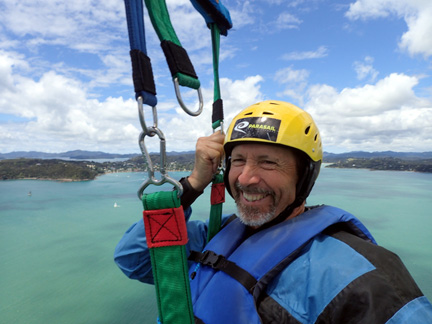
|
Romany Star arrived at the end of the tropical cruising season, as usual, with a lot of boat projects to work on. Bonnie's dad, David, agreed to mule a suitcase of boat bits from Downwind Marine to New Zealand for us - even a new alternator! It's hard to think of something to raise eyebrows at TSA more than an alternator shape, but it made it. While Paul worked on the boat, Bonnie and David ran around doing the touristy stuff in the Bay of Islands holiday destination. They had a great time admiring the view from the "highest altitude" parasailing, though they totally failed to see any sharks from up there. The town in the background is Russell, an old whaling port once known as the "hell-hole of the Pacific". The most dangerous thing Bonnie and David found there was a really fabulous chocolatery. |
| While visiting the famous Hundertwasser public toilets (seriously) David and Bonnie were lucky enough to witness the practice run of the annual biker Christmas parade. We struggled a little with the Christmas spirit the whole month, as this is our first time spending it in the southern hemisphere summer, but these bikers helped us get into the spirit. Notice the exciting columns and live roof on the building behind Santa, showing off the Hundertwasser style. He was an artistic architect who settled here towards the end of his life, and Hundertwasser art or tribute art is joyfully scattered throughout Northland. The biker is also right next to the railroad tracks that carry a wonderfully kept historic train. David asked if they could ride with the engineer, and Bonnie even got to pull the whistle! |
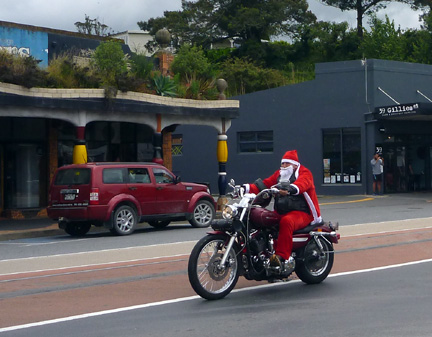
|
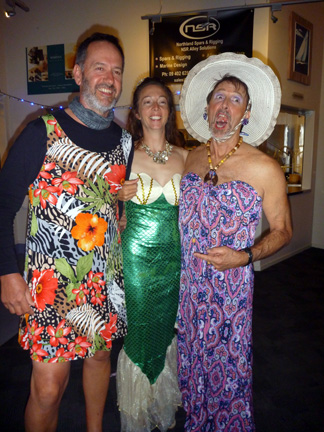
|
One of the big events that kicks off summer in the Bay of Islands is the annual Princess of the Pacific party hosted by the Opua Cruising Club and OC Tenders. The rule is that everyone must be dressed as a princess, but there the rules end. David was a great sport, wearing Bonnie's makeup and hat but in his own choice of dress. Our friend Mark was unprepared for the festivities, so had to borrow a dress off Bonnie. Paul is suspiciously absent from this picture because he was "sick". Considering he spent every day, all day, doing boat work, we gave him the night off without too much hassle. But he'd have looked fabulous as a gypsy princess. |
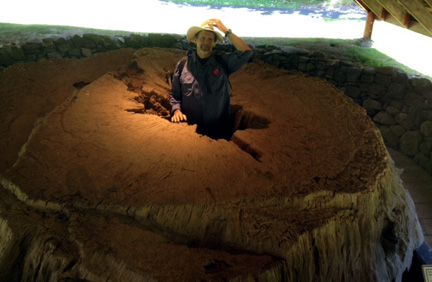
|
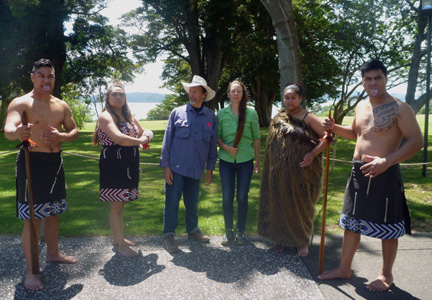
|
|
After recovering from the princess party David and Bonnie continued their tour of the area at Waitangi Treaty Ground. The Maori welcoming committee and dancers did their fierce look while David and Bonnie tried to not look intimidated. The giant kauri stump shows the size of slow-growing tree it takes to make the big waka (outrigger canoes) that paddle from this site yearly at the commmemoration of the treaty that founded the modern country of Aotearoa/New Zealand.
Look! Paul survived a whole bunch of engine work, some rigging, fixing the windvane, and a bunch of other bits and pieces that keep our princess sailing and looking her best. During the course of the boat work month both Bonnie and Paul tweaked their backs a little hauling the hookah out of the lazarette nearly daily to allow access to the back of the engine. Eventually our brilliant captain rigged a tackle to do the heavy lifting. Hooray for Paul! |
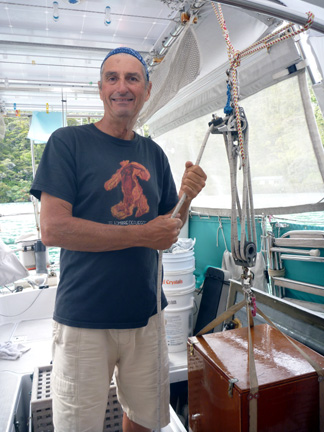
|
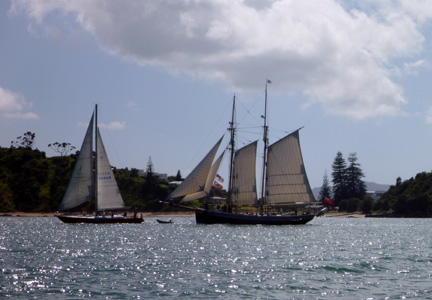
|
When we finally sailed out of the river marina of Opua we discovered that summer had brought sparkly blue water and lots of pretty sailboats to Bay of Islands. The classic rigged boat looks beautiful, but is cheating with a strong inboard motor. The red sloop's captain circled us at anchor to have a surprising conversation about knowing the previous owner of Romany Star nearly 30 years ago!
Having worked out an easy access to the hookah, Paul was faced with actually getting in the not-tropical water here to clean the growth off the bottom. He found a deal on a thick cold-water wetsuit and hood, and was rewarded with lots of hot chocolate when he was done. |
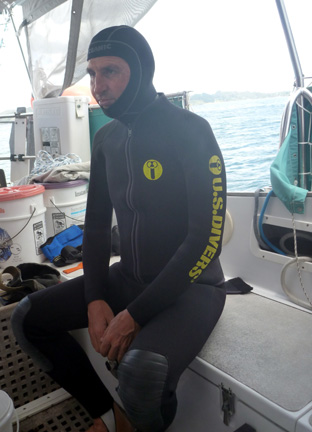
|

|
|
It's easy to see how Bay of Islands became such a popular sailing destination. The beautiful lacework of islands seem to be shaped with the intention of offering as many beautiful protected anchorages as possible. We spent a couple weeks enjoying the walking tracks, views and fantastic kayaking.
As we were planning to try to sail around the north cape and down the west coast of the North Island, we sailed up the coast to the fishing-centric Whangaroa harbor. Bonnie got an itch to enjoy socializing for the holidays, so we anchored off the main town. We had a ball at a holiday quiz night at the local fishing club, though our team came in last. The silliness involved challenges like eating a whipped-cream topped merengue without liking one's lips. Paul failed dismally, but enjoyed the merengue. We also enjoyed a rather singular caroling event at a historic little wood chapel. The leader took us from religious hymns to a fully interactive 12 Days of Christmas in which we were assigned actions. You haven't really enjoyed Christmas songs until you've witnessed the church ladies doing "six geese a-laying"! |
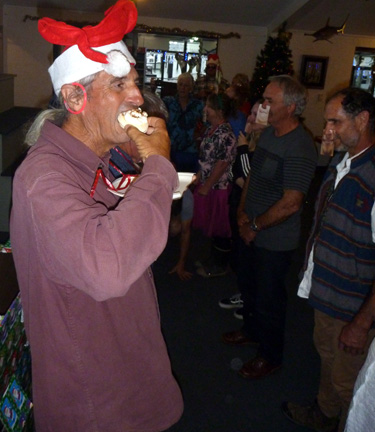
|
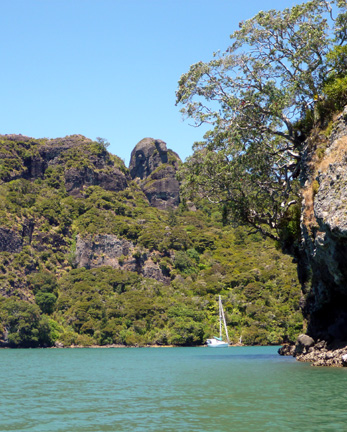
|
It's amazing how the landscape and geology in New Zealand can be so different only a few miles away. Rather than the gently rolling hills of Bay of Islands, Whangaroa harbor is more like a sunken Canyonlands. Dramatic rock formations and sheer faces rise over the extremely calm water. After entering through a very narrow opening in the seaward cliffs, the bay opens into several large lobes on each side, each with various coves, beaches and streams. Pretty little Lane Cove was a particular favorite of ours, with the "Duke's Nose" rock formation above it.
In the foreground (indeed everywhere in the bay) the tidal rocks are thickly encrusted with oysters. Smaller and sweeter than the local oysters, these are a Japanese variety that are being commercially farmed at the back of the bay. Of course no one can contain microscopic oyster spawn, so locals simply enjoy the bounty. We were laughingly warned to "only" take fifty oysters per person per day! |
|
There were a couple lovely walking tracks around Whangaroa, but Bonnie's favorite pastime was exploring by kayak. At high tide we could paddle up a pretty little river and enjoy the plants artistically overhanging the stream while the birds called overhead. There was very high waterfall down a sheer face that was just a trickle on nice days, but an impressive torrent on rainy ones.
We chose to use this protected anchorage area to sit out a big storm just after the New Year. For nearly two days big gusts swooped down the canyons and laid us to one side or the other as we spun around our anchor. We saw dozens of boats reanchor as the 60-70kt wind dragged them around. Hooray for our big Rocna! But that storm did convince us that we'd rather not risk sailing through the Tasman sea to go south. We reoriented ourselves to find a place to leave Romany Star while we toured the South Island by land transport. |
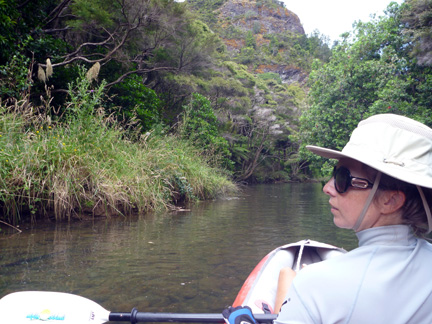
|
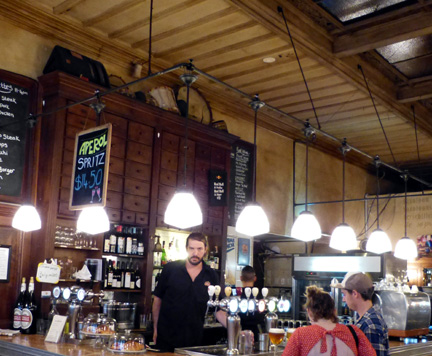
|
Though Wellington is New Zealand's cultural and political capitol, the largest city by far is Auckland. We had a few hours to see downtown Auckland between buses, and happily found a historic pub serving dinner and a dizzying variety of beer. The British bartender complimented the atmosphere of historic photographs and old instruments. By the time we caught our overnight sleeper bus we were well-prepared to snore the night away south to Wellington. |
| Wellington is a charmingly dense city that is seemingly made for walking. On our third day we found out why it is nicknamed "Windy Welly", when a hurricane blew through and bent the wind sculptures to the ground. It's the perfect place for dynamic sculptures, provided they are strong and well-grounded. But we lucked out and enjoyed beautiful sunny weather for our first two days in town. When we arrived with the morning rush hour we dropped our hiking packs in a hotel locker and were soon at the beautiful Botanic Gardens on a hilltop overlooking the city. The historic cable-car is cute, but seemed unsporting when we were supposed to be training for the southern mountians. |
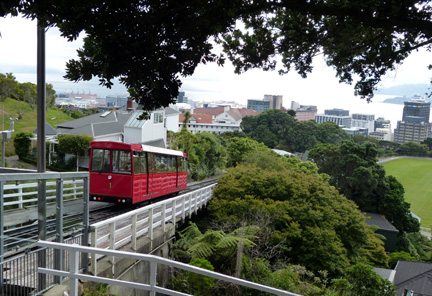
|
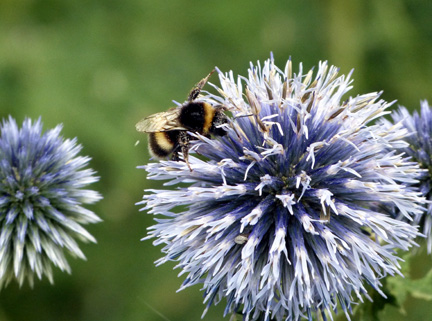
|
It was the height of summer, which meant a Botanic Garden full of very happy bees. We encountered so many unfamiliar plants that we had trouble picking a photo, and were also charmed by the collection of lovely desert plants from the southwest US and around the world. As we later walked along the waterfront we discovered that summer also meant lots of people swimming in the harbor. There was a line of all ages waiting to jump off an informal diving board into the surprisingly clear water. I expected a large harbor like this to be dirty, but apparently most of the big shipping comes into Taurganga rather than here at the bottom of the island. We didn't ask how cold that ocean was as we walked to the deservedly famous Te Papa national museum. We found the presentation of Maori culture at the Te Papa to depict a lively and evolving culture with deep roots, rather than one in history only (as we've seen elsewhere in presentations of Polynesian cultures). |
| Windy Welly is also the home of the world famous Weta special effects studios, whose work is showcased in the Lord of the Rings movies and Avatar, among many others. The studio giftshop and tour areas are packed with full-size (or larger) characters, particularly monsters. Weta loves monsters of all kinds, and does them well. No penguins were injured in the taking of this picture, though we think Gus may have peed on the troll's toe. We enjoyed a fascinating tour in which we got to handle real costumes and props, and learn from the artists who make them. We were also amused to learn that Weta does a strong business in jewelry - anyone want to get married with the One Ring to rule them all? |
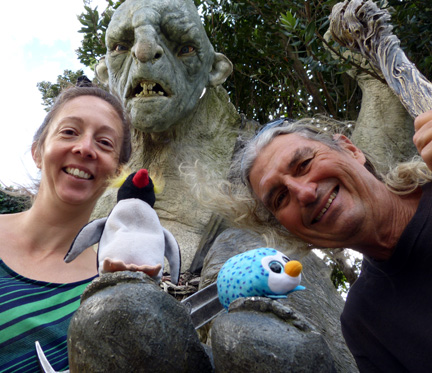
|
| We flew from Wellington to Christchurch on the South Island, where we rented a car and started driving across to the Southern Alps on the western side. Much of the center of the South Island is desert scrub, after the early settlers burned off the native forest to make the land suitable for sheep. After hours of scrub it was a relief to find the frequent lakes that collect rain and glacial melt off the big western mountain range. We picked up a very nice young French woman for this day of driving, who was aiming to hike up big Mt. Cook we see in this picture. |
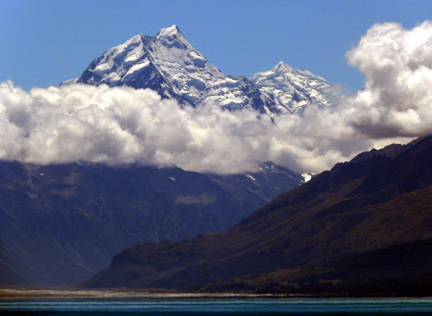
|
||||||||
|
|
|||||||||
Milford TrackAfter two days of driving we arrived at the start of the Milford Track. One of the New Zealand Department of Conversation (DOC) Great Walks, Milford Track is world renowned for it's pristine rugged beauty. Just a few days before, while we were admiring the wind sculptures in Windy Welly the Milford Track was closed because of extreme weather and flooding. When that happens the folks who were reserved for those days are just out of luck. We got lucky in that our reservations from eight months earlier found us a decent weather window. Unfortunately Bonnie was not so lucky with her knee, which she twisted when picking up her pack at a hostel the morning before. She didn't want to miss this opportunity to do something Paul has always dreamed about, and decided to push ahead with the hike. |
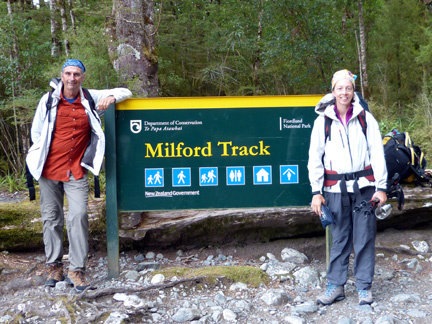
|
||||||||
|
|
|||||||||

|
Day one we crossed huge Lake Te Anau in a water taxi and hiked along the crystal-clear Clinton River to the first of the DOC huts. Deluxe accomodations for a backpacking trip included gas stoves, bunks with mattresses, and flush toilets . . . no showers though. One family of hikers bathed in the glacial-melt river, but most of the 40 people in the hut just figured they'd smell for a few days.
Day 2 started with the sad decision for Bonnie to turn around. The problem with her knee was going to make the climbs and decents ahead impossible for her. She hiked the fairly flat 5k back to meet the water taxi back to Te Anau village to wait for Paul to complete the four day hike. Paul continued up the Clinton river valley toward it's head waters. The weather was damp and chilly, but that put the waterfalls on full show all day. |
||||||||
|
|
|||||||||
| Day3 is the big deal. The ascent to Mackinnon Pass from the second hut is steep and majestic. | |||||||||

|
|||||||||
|
|||||||||
|
|||||||||
|
|
|||||||||
|
|||||||||